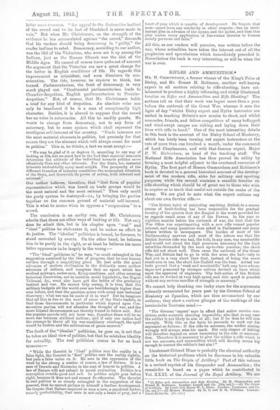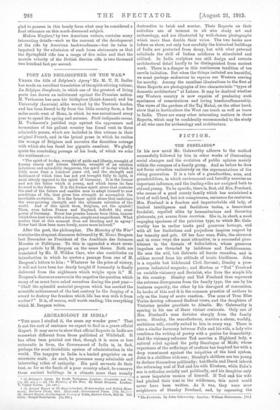RIFLES AND AMMUNITION.*
MB. H. OMMUNDSEN, a former winner of the King's Prize at Bisley, and Mr. Ernest H. Robinson, another well-known expert in all matters relating to rifle-shooting, have col- laborated to produce a highly informing and richly illustrated treatise on Rifles and Ammunition and Rifle Shooting.' -ne authors tell us that their work was begun more than a year before the outbreak of the Great War, whereas it sees the light of day "whilst Bisley expert and Hythe instructor are united in teaching Britain's new armies to shoot, and whilst comrades, friends, and fellow-competitors of many beflagged and wind-swept ranges are risking and laying down their lives with rifle in hand," One of the most interesting details in this book is the account of the Bisley School of Musketry, which has lately been turning out expert instructors at the rate of more than one hundred a month, under the command of Lord C/heylestnore, and with that famous expert, Major P. W. Richardsou, as head of the teaching staff. The National Rifle Association has thus proved its utility by forming a most helpful adjunct to the overtaxed resources of Hythe. The first part of Messrs. Ommundsen and Robinson's book is devoted to a general historical account of the develop- ment of the modern rifle, alike for military and sporting purposes, while the second contains a sensible treatise on rifie.shooting which should be of great use to those who wish
to acquire or to teach that useful art outside the ranks of the Army. We are glad to note what the expert authors say about our own Service rifle :—
”The British habit of subjecting anything British to a severe course of fault-finding has been responsible for the gradual forming of the opinion that the Empire is the worst provided for as regards small arms of any of the Powers. in the year or eighteen months before the outbreak of war, the hint that the War Office was experimenting with a new rifle roused popular interest, and ninny questions were asked in Parliament and runny letters written to newspapers. The burden of most of the Parliamentary answers and most of the letters was that the British Service rifle was bad, the bolt, in any case, was unscientific and would not stand the high pressures necessary for the high velocities demanded by the most up-to-date practice; the short rifle did not shoot -well. Then came the outbreak of the Great War, and Britain had to go in with the arms she had—only to find out in a very short time that, instead of being the worst small-arm in use, the short Lee-Enfold was the best. Actual war tests proved that a weak and unscientific' bolt may have advan- tages not possessed by stronger actions devised on lines which meet the approval of engineers. The holt-action of the British ride can be worked at vary high speed, and this speed is possible without any serious sacrifice of strength or accuracy."
We cannot help thanking our lucky stars for the arguments solemnly enunciated for years past by the German School of Musketry at Spandau, which are thus summarized by our authors ; they show a curious glimpse of the workings of the incalculable Teutonic: mind :—
"The German 'expert' says in effect that active service con- ditions make accurate shooting impossible; also that in any case the soldier is not likely to aim at all but if he does he will aim wrongly. With this as the basis he proceeds to work out his argument as follows : If the rifle be accurate, the soldier aiming wrongly will always miss his mark. The only chance of hitting will therefore depend on some inaccuracy in the rifle or ammuni- tion. Therefore it is necessary to give the soldier a rifle which is not too accurate, and ammunition which will develop errors big enough to correct the soldier's bad aim I" Lieutenant-Colonel Hime is probably the classical authority on the historical problems which he discusses in his valuable little book on The Origin of Artillery.= Part of this volume is a revised reprint of his Gunpowder and Ammunition ; the remainder is based on a paper which he contributed to Vol. XXXI. of the Journal of the Rayed Artillery. 'We are • (1) Rifles and Amtnunitien and Rigs Shooting. By H. Onmaundson and Ernest IT Robinson. London: Cassell and Co. f218. net.3-1(2) The Origin of A Kitten. By Lieut.-Cot Henry W. L. lime. London Long:nails and CO. [de. net.1—(3) Modern 'Warfare. By 11, S. and E. li, Williams. London Brant Richards. Dis, La.] glad to possess in this handy form what may be considered a final utterance on this much-discussed subject.
Modern Warfare,' by two American writers, contains many interesting details—such as the account of the development of the rifle by American backwoodsmen—but its value is impaired by the admission of such loose statements as that the Springfield rifle has a range of five miles and that the muzzle velocity of the British Service rifle is two thousand two hundred feet per second.



































 Previous page
Previous page